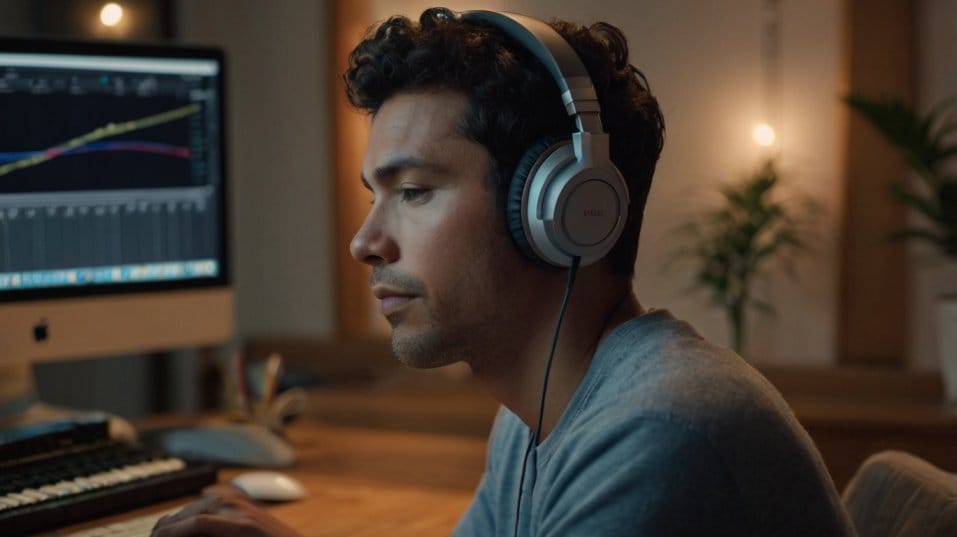The Role of Sound and Music in Enhancing Mindfulness at Work
Leverage sound and music to boost mindfulness at work. Learn how soundscapes and silence improve focus, reduce stress, and enhance performance.

What if the secret to better focus and less stress wasn’t silence, but sound? The right audio can sharpen attention, regulate emotions, and turn workplace noise into an ally.
Instead of fighting distractions, you can use music, nature sounds, or even mindful silence to create a more balanced and productive work environment.
Sound isn’t just background—it shapes your mental state, influencing how you think, feel, and perform throughout the day.
The Science Behind Sound and Mindfulness
Sound has a direct line to the brain, shaping cognitive function and emotional states. Certain frequencies influence brainwaves, nudging the mind into focus or relaxation.
Binaural beats, which introduce slightly different tones in each ear, can sharpen concentration or encourage calm. Studies show that these frequencies can promote alpha or theta brainwave states, associated with creativity and deep focus.
White noise and pink noise, both used in cognitive therapy, help the brain filter distractions and maintain steady attention.
The Benefits of Nature Sounds and Silence
Nature soundscapes—waves, birdsong, rustling leaves—engage the parasympathetic nervous system, lowering cortisol and easing tension.
Exposure to natural sounds has been linked to enhanced cognitive performance and emotional balance. Even silence, when intentionally applied, improves cognitive processing and focus.
Research from the Journal of Neuroscience suggests that periods of silence help the brain regenerate neurons, leading to improved learning and memory retention.

Instead of treating workplace noise as a nuisance, use it as a mindfulness trigger. The clatter of keyboards, distant conversation, the whir of an air conditioner—each sound exists in the present.
Noticing these without resistance turns ambient noise into a tool for presence. Training yourself to observe sound without judgment fosters a stronger ability to remain focused despite external stimuli, reinforcing resilience against distractions.
Music as a Catalyst for Focus and Calm
Music isn’t just background noise; it’s an active performance enhancer. Instrumental tracks—classical, lo-fi, ambient electronic—support concentration, while lyrics can interfere with verbal processing.
Rhythmic stability maintains cognitive flow, while erratic patterns disrupt it. Studies in neuroscience suggest that specific tempos can entrain brainwave activity, helping professionals stay in an optimal cognitive state.
Choosing the Right Music for Work
For deep focus, music with a tempo between 50-80 beats per minute is often most effective, as it mimics the pace of a relaxed but alert state.
For stress relief, softer sounds and slower tempos work best. Tracks around 60 beats per minute sync with resting heart rates, promoting relaxation.
Meditation soundtracks, nature-inspired compositions, or even jazz can create a sense of calm between meetings.
Some genres, like ambient electronic, are specifically designed to induce trance-like states that enhance problem-solving and creative thinking.
The Psychological Effect of Music
There’s also a psychological element to music’s effect on mindfulness. Familiarity with certain tracks can signal the brain to enter a specific mode—much like athletes using pre-game playlists to boost motivation.
Curating a personal work playlist can help create consistent mental associations, priming your brain for focus or relaxation as needed.
Designing a Mindful Sound Environment
Mindful workspaces aren’t just about reducing noise; they’re about shaping it. Open offices often lead to overstimulation, but noise-canceling headphones or white noise machines can create a protective soundscape.
On the other hand, complete silence can feel isolating—adding ambient nature sounds or curated playlists can balance the atmosphere.
Choosing the right auditory environment isn’t just about volume—it’s about the type of sound and how it interacts with your cognitive state.
Optimizing Your Auditory Environment
Experiment with volume. Too loud overwhelms, too soft fades into the background. Schedule sound breaks—pause for a calming track, a deep bell chime, or a moment of silence.
These breaks act as resets for your brain, improving information retention and reducing cognitive fatigue. Many workplaces now incorporate quiet zones or meditation sound apps to support mindfulness.
Another factor is spatial sound awareness. Directional audio, such as speakers placed at strategic angles or using binaural recording techniques, can create immersive sound environments tailored for focus.
Some organizations are even experimenting with soundscaping—designing entire workplace environments with customized ambient sounds to enhance concentration and reduce stress.
This approach borrows from biophilic design principles, which integrate natural elements into architecture to promote well-being.
Practical Applications of Sound for Mindfulness at Work
Bringing mindfulness into your workday doesn’t have to be complicated. Sound can serve as a powerful tool to ground your attention, enhance focus, and create a sense of balance.
By integrating intentional auditory cues, you can reinforce mindful habits throughout the day.
Use Sound as a Mindfulness Anchor
Set intentional auditory cues throughout the day—a specific chime to signal deep work sessions, a soft bell to prompt a breath break, or nature sounds to unwind after intense meetings.
Adjust Sound Based on Task Type
For analytical work, low-volume instrumental music or white noise enhances focus.
For creative brainstorming, dynamic and slightly unpredictable soundscapes can stimulate new ideas. For deep relaxation, consider guided meditation with carefully designed audio layers.
Train Your Brain with Sound Associations
Repeated exposure to specific music or sounds before starting work creates a conditioned response—your brain will automatically associate that sound with focus, reducing transition time between tasks.
Incorporate Sound Therapy Practices
Techniques like sound baths, which use resonant frequencies to encourage deep relaxation, or singing bowls that promote mindful breathing, can be integrated into the workday to enhance emotional regulation.
Experiment with Silence
Absolute silence can be just as powerful as sound. Short moments of complete quiet—especially when paired with mindful breathing—help reset your nervous system, improving clarity and emotional balance.
Final Thoughts
Sound isn’t something to escape—it’s something to use. Whether through music, nature sounds, or controlled silence, refining your auditory environment enhances focus, lowers stress, and improves overall work performance.
The key is to experiment and observe how different sounds impact your cognitive and emotional state.
Start now: tune in to your surroundings, make small adjustments, and see how sound reshapes your mindfulness at work.
Try a new playlist, introduce intentional silence, or explore nature soundscapes. The right auditory choices can transform your productivity and well-being in ways you might not expect.




